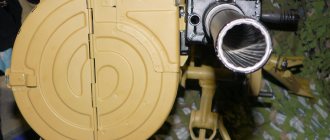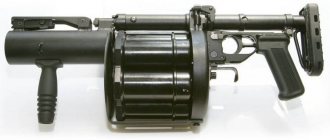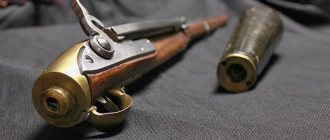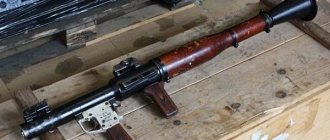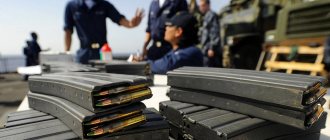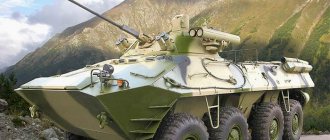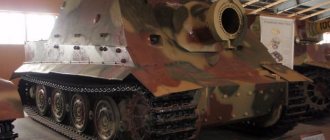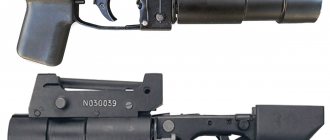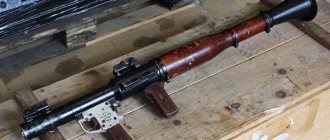History of creation
The small grenade launcher system "Bur" was developed by the Tula Instrument Design Bureau, based on the infantry rocket flamethrower "Shmel".
At the same time, the mass of the prototype was no more than five kilograms. The main purpose of the Bur MGK is the ability to destroy enemy personnel, unarmored vehicles, light armored vehicles, and damage structures and shelters.
The first demonstration of the Bur small-sized grenade launcher system took place in the fall of the year, during the INTERPOLITEX exhibition in Russia. After receiving high marks from Russian specialists, they decided to demonstrate the Bur MGK at the European exhibition EUROSATORY-2014, held in Paris. Later it was reported that the Belarusian holding BelOMO had developed several types of sights for the grenade launcher - thermal imaging, night and day optical.
According to media reports, dated October 21, 2014, the Tula Instrument Design Bureau has launched serial production of the Bur MGK for further delivery to Russian law enforcement agencies. In June 2016, the Bur MGK was adopted by anti-terrorism units.
Who invented and how did the super-light Bur grenade launcher appear?
A new type of hand grenade launcher received its real outlines within the walls of the Tula Instrument Design Bureau. The development of the project was carried out on the basis of the RPO-PDM-A flamethrower of the “Shmel” type. It was decided to subject this model of infantry weapons to deep modernization. The designers were tasked with achieving a significant reduction in the weight of the product in combat equipment and obtaining acceptable dimensions. Tula engineers brilliantly coped with the task, creating a unique infantry weapon - the Bur MGK.
Bumblebee
The first prototype of a new generation grenade launcher was demonstrated to the general public at the Interpolitech exhibition in 2013. The declared parameters surprised military experts in the field of infantry weapons. I also liked the manufacturability of the grenade launcher’s design, which made it possible to quickly master the mass production of the product. The following year, the Bur grenade launcher was introduced to the international arms market for the first time.
Exhibition
A fundamentally new infantry weapon is the fruit of the practical implementation of a number of innovative ideas that have been successfully tested on other modifications of similar products. Rational and competent use of technical innovations has made it possible to achieve a significant reduction in the weight and size of the grenade launcher. In the product card presented on the exhibition walls, in the weight column, there is a figure of 4.8 kg, and in the column for the length of the grenade launcher there is a figure of 742 mm.
It becomes interesting that the new grenade launcher has such parameters, which uses the same layout: a transport-launch container and a launching device. The launching device can be used repeatedly, equipped with a new transport-launching device with a live projectile. A new type of sighting device can be installed on the launcher, which is also planned to be produced to equip new types of small arms.
https://youtube.com/watch?v=lLnOtklTy3s
The main purpose
The list of tasks that are successfully solved using various grenade launchers speaks for itself:
- Destruction of all types of moving small targets (tanks, armored vehicles, infantry fighting vehicles, trucks, river and sea boats, etc.);
- Suppression and destruction of fortified firing points (bunkers, armored caps, pillboxes and simply machine gun nests);
- Defeat enemy fire weapons and manpower located both in open areas and in trenches, as well as on reverse slopes and in ravines;
- Fight against low-flying enemy aircraft, primarily fire support helicopters.
UH-60 "Black Hawk", shot down in Mogadishu in October 1993. The Americans believe that the helicopter was destroyed by a grenade launcher shot
Of course, there are no grenade launchers that would be capable of solving all these problems equally successfully. Each of the subtypes of these weapons has its own specialization.
Features of the combat use of the Bur grenade launcher
The operation of the product deserves attention. To transport weapons, the fighter is equipped with a “backpack” type bag. The bag uses special fastenings and has a number of compartments for conveniently carrying a grenade launcher, sighting devices and transport and launch containers. A grenade launcher can independently carry a backpack with three TPKs equipped with live grenades at a time.
Special forces soldiers equipped with this type of infantry weapon can freely land and easily move over rough terrain. The complex deploys into combat mode within a matter of seconds. The weapon does not require special skills or outside assistance for use in a combat situation.
Application
The product designers managed to significantly increase the operational life of their brainchild. The launch device can be used up to 500 times, and the transport and launch container is made of materials that ensure low cost of disposable products.
Today it is known that the Bur small-sized rocket launcher is already in mass production. FSB units, special forces of the National Guard and other law enforcement agencies of Russia are equipped with a new type of grenade launcher. It became known that the Navy Department had acquired a certain number of new type grenade launchers to equip Marine Corps units. It is no secret that the Bur grenade launcher has begun to be equipped with airborne troops.
RPG LAW M72 - American anti-tank grenade launcher
In the early seventies, the United States began developing a new close-combat anti-tank weapon that could be controlled by a single soldier. They wanted to not only replace the outdated Bazooka grenade launchers, but also use them to protect buildings not covered by anti-tank defense guided missiles. The weapon was developed by the American company Hesse Eastern Co., and in 1969 it was put into service with the American army. Grenade launchers of this type are included in the equipment of the armies of Australia, Belgium, Denmark, Great Britain, Israel, Canada, the Netherlands and Austria. In Norway, the American disposable RPG LAW M72 A2 and M72 A3 are produced under license.
Read more…
(by country)
Countries
| Australia |
| Austria-Hungary |
| Belgium |
| Bulgaria |
| Great Britain |
| Germany |
| Israel |
| India |
| Spain |
| Italy |
| China |
| Korea South |
| Poland |
| Russia/USSR |
| Singapore |
| Slovakia |
| USA |
| Ukraine |
| Finland |
| France |
| Czechoslovakia |
| Switzerland |
| Sweden |
| South Africa |
| Yugoslavia |
| Japan |
Countries
| Australia |
| Austria-Hungary |
| Belgium |
| Bulgaria |
| Great Britain |
| Germany |
| Israel |
| India |
| Spain |
| Italy |
| China |
| Korea South |
| Poland |
| Russia/USSR |
| Singapore |
| Slovakia |
| USA |
| Ukraine |
| Finland |
| France |
| Czechoslovakia |
| Switzerland |
| Sweden |
| South Africa |
| Yugoslavia |
| Japan |
Mk20/Mark 20 grenade launcher
In the mid-1960s, the Naval Ordance Station in Louisville, Kentucky began developing a new grenade launcher. In 1967, the Honeywell Corporation presented a prototype of the new Mk20 mod 0 grenade launcher, and in 1968, the first batches of this weapon began to enter the military. The Mk 20 became the first automatic grenade launcher for the 40x46 mm grenade.
- Weapons » Grenade launchers » USA
- 5914
More details
FN GL1 grenade launcher
In 2001, the Belgian company FN Herstal introduced the FN F2000 modular rifle system, which includes an assault rifle and auxiliary modules, which included the FN GL1 40-mm grenade launcher. The FN GL1 grenade launcher was designed specifically for use with the FN F2000 assault rifle and is mounted on the rifle instead of a detachable forend.
- Weapons » Grenade launchers » Belgium
- 5937
More details
Baryshev ARGB grenade launcher
The Baryshev automatic hand grenade launcher - ARGB is designed to destroy single and group enemy targets with fragmentation grenades at distances of up to 1000 m. Almost all the advantages of the ARGB, characteristic of the KPB machine gun, are fully embodied in the Baryshev automatic hand grenade launcher.
- Weapons » Grenade launchers » Russia / USSR
- 6034
More details
XM25 grenade launcher
The main purpose of the XM25 is to expand and complement the fire capabilities of infantry at the squad level. It was intended that this system would complement existing squad-level fire support weapons such as 40mm grenade launchers (M203 or XM320) and M249 SAW light machine guns.
- Weapons » Grenade launchers » USA
- 6048
More details
Small-sized grenade launcher system Bur
In the early 2010s, the Tula KBP developed a new grenade launcher, designated MGK "Bur". The new weapon was created on the basis of the concept of the RPO-M Shmel infantry flamethrower, but became noticeably smaller and lighter than its predecessor, while maintaining fairly high combat characteristics.
- Weapons » Grenade launchers » Russia / USSR
- 6076
More details
M20 / M20A1 / M20A1B1 Super Bazooka grenade launcher
The 88.9 mm (3.5') M20 "Super Bazooka" anti-tank rocket gun was adopted by the American Army in 1945.
- Weapons » Grenade launchers » USA
- 6265
More details
Grenade launcher GP-25 "Koster"
As a result of the work of the design teams of TsKIB SOO in Tula and State Research and Production Enterprise “Pribor” in Moscow, the 6G15 grenade launcher was developed, successfully tested, and in 1978, based on the results of the PI, the 6G15 grenade launcher was recommended for service with the SA (later assigned the index GP-25, theme “Bonfire”) and a shot at him with a VOG-25 fragmentation grenade (index 7P17).
- Weapons » Grenade launchers » Russia / USSR
- 6268
More details
Mk.19 / Mark 19 grenade launcher
The US Navy initiated development of the Mark 19 (Mk.19) automatic grenade launcher in 1966, based on positive experience with the 40 mm (40x43) Mark 18 grenade launcher developed by Hughes in 1962.
- Weapons » Grenade launchers » USA
- 6298
More details
T148E1 grenade launcher
Even before the end of the XM79 program (for the M79 grenade launcher), engineers at the Springfield Armory began new design programs to create a multi-charge 40-mm grenade launcher, which had the indexes T148E1 and T148E2.
- Weapons » Grenade launchers » USA
- 6326
More details
M203 / M203PI grenade launcher
The M203 grenade launcher was developed between 1967 and 1968 by the American corporation AAI under a contract with the US Army. The development of the M203 was based on the experience gained from the widespread use of the 40-mm M79 grenade launcher by American troops in Vietnam.
- Weapons » Grenade launchers » USA
- 6330
More details
Milkor MGL grenade launcher
The development of the Milkor MGL multi-shot grenade launcher, designed for low-velocity 40 mm (40x46) caliber grenades, began in South Africa in the early 1980s, based on the successful experience of operating American M79 single-shot grenade launchers.
- Weapons » Grenade launchers » South Africa
- 6354
More details
RPG-76 Komar grenade launcher
The RPG-76 Komar grenade launcher was developed at the Military Technical Institute of Weapons (WITU) in Zelenka (Poland).
- Weapons » Grenade launchers » Poland
- 6459
More details
Small-sized grenade launcher system Bur
Small-sized grenade launcher system "Bur"
In the early 2010s, the Tula Instrument Design Bureau (KBP) developed a new grenade launcher, designated MGK "Bur". The new weapon was created on the basis of the concept of the RPO-M Shmel infantry flamethrower, but became noticeably smaller and lighter than its predecessor, while maintaining fairly high combat characteristics.
The Bur MGK was created to solve most tasks of fire support for infantry in a variety of close combat conditions and is designed to destroy enemy personnel, unarmored vehicles, light armored vehicles, damage structures and shelters.
Structurally, the Bur grenade launcher system consists of two main components - a reusable launch device (PU) and rocket rounds, which are located in special disposable transport and launch containers (TPC).
The main components of the MGK Bur: transport and launch container (TPC), launching device (PU) and optical sight (OP)
The starting device, made of impact-resistant plastic, is designed in the form of a pistol grip with a small ribbed fore-end. It contains a trigger mechanism, a safety device, a mount for installing a TPK with a grenade, as well as a small-sized generator that generates the electrical impulse necessary to fire a shot.
Starting device MGK Bur
On the left side of the PU there is a mounting bracket designed for mounting a variety of sights. The device can be equipped with a day or night optical sight, as well as a thermal imaging sight. The standard sight for the grenade launcher is the PGO-BUR optical sight. In addition, a laser rangefinder can be installed on the device.
The grenade launcher uses 62 mm rounds as ammunition:
- high-explosive fragmentation - designed for fragmentation destruction of openly located unprotected enemy forces in a given area of at least 80 square meters, as well as for disabling automotive equipment;
- high-explosive - designed to destroy openly located manpower in an area of at least 50 square meters, destroy and damage buildings, disable unarmored and lightly armored vehicles.
Grenade launcher rounds consist of a container, a motor and a grenade. The container and engine are universal for all shots, only the grenade equipment changes. At the same time, the design of the warhead is made in such a way that the external ballistics remain unchanged.
From left to right: day optical sight, night optical sight, thermal imaging sight
Each shot is packed at the factory in a plastic TPK, hermetically sealed at the ends with rubber caps, which are automatically knocked out at the moment of firing. For firing, the transport-launch container with a grenade is attached to the launcher. After the shot, the empty TPK is removed from the launcher and thrown away. The grenade is stabilized along its trajectory by deployable spring-steel tail fins.
| Caliber, mm | 62 |
| Shot length, mm | 742 |
| Weight, kg - shot - PU with optical sight | 3.5 1.5 |
| Firing range, m - maximum - sighting with optical sight - minimum | 950 650 25 |
| Accuracy of fire at a distance of 200 m - Vv - Vb | ≤ 0,5 ≤ 0,5 |
| Temperature range of application, °C | -40 — +60 |
| PU resource, count. shots | ≥ 500 |
To ensure high shooting accuracy, a “reactive-active” grenade throwing scheme was used, since the use of traditional schemes by increasing the energy capabilities of the starting propulsion system or introducing a sustainer engine operating on a trajectory leads to an increase in overall weight characteristics in the first case and an increase in dispersion in the second. The principle of operation of the “reactive-active” throwing scheme is to accelerate a grenade placed in a barrel attached to a jet engine due to jet thrust and simultaneous active acceleration in a moving barrel due to the selection of gases from the engine chamber. At the same time, the barrel with the engine stops, imparting additional speed to the grenade. This ensures an increase in the energy imparted to the grenade and, accordingly, the initial speed, compared to grenade launchers of traditional designs with the same container length.
The small-sized grenade launcher system "Bur" is a compact, lightweight and easy-to-use weapon. It can be used to hit targets at a distance of up to 950 meters, while the effective firing range with a daytime optical sight is 650 meters, and the minimum permissible firing range is only 25 meters. When equipped, it weighs no more than 5 kg. The launcher is capable of withstanding at least 500 shots.
Also, the positive qualities of the grenade launcher include the following set of advantages and application features:
- equipment with various types of shots;
- the ability to use various types of sights, depending on the conditions of use;
- high efficiency and power of ammunition with low weight and small dimensions;
- the ability to fire from enclosed spaces with a volume of 30 cubic meters;
- the complex is easy to use, always ready for use from the “standing”, “lying” and “kneeling” positions, including in conditions of limited visibility;
- is highly reliable and safe to use;
- Convenient for transportation, movement over very rough terrain, and airborne landings.
The first demonstration of the Bur MGK took place in the fall of 2013. In 2014, the grenade launcher was adopted by the Russian army. Serial production of these weapons was launched by the Tula Instrument Design Bureau.
MGK Drill with used shots
Distinctive design features of the Bur grenade launcher
Considering the design of a grenade launcher in detail, one should dwell on the launching device of the missile system. As in other similar products, the most convenient L-shaped design is used here, equipped with a fore-end and a pistol grip. The trigger mechanism is activated using a trigger and mechanical flag-type regulators located on the side surface of the device body. The trigger mechanism is equipped with a fuse, and the body has provisions for installing sighting devices.
It is planned to equip the product with both optical and night sights, as well as sighting devices with thermal imagers. This equipment allows you to use a rocket-propelled grenade launcher at any time of the day and in any weather conditions. Due to the installation of sighting equipment, the product allows targeted fire at a distance of up to 700 m. The maximum range of a direct shot from the Bur grenade launcher reaches 1 km.
If we move on to the combat configuration, then everything here looks traditional. The weapon is capable of firing two types of combat grenades of a unified design. Even at the manufacturing stage, both ammunition is placed in a transport and launch container. This part of the complex is both an arsenal and a means of transportation. Externally, the container looks like a pipe equipped with hermetically sealed lids at both ends. The device protects ammunition from external influences during transportation and storage and simultaneously serves as a guiding structure for launching a grenade. The product is designed for one-time use. A starting device is attached to the bottom of the container. The total weight of the container when loaded is only 3.5 kg.
The 62 mm caliber grenade has a cylindrical body. The head part is round, hemispherical in shape. There are four stabilizers in the tail section, which open after the projectile is launched and exits the container. Stabilizers open according to the principle of a spring due to their elasticity. Thanks to the presence of stabilizers, the flying projectile receives a torque, thereby keeping it on the required flight path. When firing from a grenade launcher at direct shot distances, the accuracy of the grenade does not exceed 0.5 m. The projectile flies out of the launch container at a speed of 130 m/s.
Today it is known that the Bur small-sized rocket launcher is already in mass production. FSB units, special forces of the National Guard and other law enforcement agencies of Russia are equipped with a new type of grenade launcher. It became known that the Navy Department had acquired a certain number of new type grenade launchers to equip Marine Corps units. It is no secret that the Bur grenade launcher has begun to be equipped with airborne troops.
Tactical and technical characteristics of the Bur grenade launcher
Type: jet Firing range: minimum - 25 m; maximum - 950 m; sighting with an optical sight - 650 m Weight of the launcher with an optical sight: up to 1.5 kg; shot - 3.5 kg Caliber: 62 mm. Shot length: 742 mm. Temperature range of use: from –40 to +60°C. Allowable number of shots from the launcher: at least 500. Accuracy of fire at a distance of 200 m: probability of height deviation (Vv) ≤ 0.5; by lateral deviation (Wb) ≤ 0.5.
Design
The Bur grenade launcher system includes two main components:
- fiberglass self-contained housing for rocket motor.
- device for launching ammunition. Consists of a trigger, pistol grip, manual safety, handguard with ribbed structure, bracket for mounting optical sights or rangefinders.
The kit for carrying spare rocket engine casings to the grenade launcher includes a special backpack bag with a capacity of up to three casings.
The Bur grenade launcher system is capable of using both high-explosive fragmentation and thermobaric grenades.
Device
The Bur grenade launcher consists of two main parts:
- rocket motor housing made of fiberglass;
- trigger device for ammunition, including a trigger, pistol grip, manual safety, handguard with a ribbed structure, bracket for mounting rangefinders or optical sights.
To carry rocket engine housings, a special backpack bag designed for three housings is provided. The grenade launcher itself is transported using a special strap attached to the body.
History of creation
The first type of weapon that to some extent resembled a grenade launcher was hand-held mortars. They appeared at the turn of the 15th and 16th centuries. The unknown inventor of a new weapon for those times simply replaced the small cannonball that was used to load the squeaks with a grenade loaded with black powder. Hand-held mortars can be seen today in many museums, however, they usually did not find wide use among the troops. In the Russian army during the reign of Peter I, this weapon was introduced as a means of self-defense for artillerymen, but was then considered unsuitable for field battles.
Several different versions of a hand-held mortar - a prototype of a grenade launcher
The low efficiency of hand-held mortars was due to very strong recoil: they had to shoot while resting the back of the barrel on the ground or on the deck of a ship. In essence, this weapon was more like a small mortar. In addition, grenades of those times had a low destructive effect.
Another prototype of a modern grenade launcher was a gun patented in 1718 by London lawyer James Puckle. This invention can also be considered an early ancestor of the machine gun or even the automatic shotgun. The “gun” was equipped with a quick-change drum, which housed 11 ready-to-fire charges. The caliber is large enough to replace the large bullets proposed by Pakl with small grenades. Contemporaries did not appreciate the invention: it was too complex for the 18th century.
"Pakla's Gun" in the museum. It is clearly visible that the charges are not inferior in size to grenade launcher rounds
At the beginning of the twentieth century, the old idea of a hand-held mortar was returned, but at a qualitatively different level. The first muzzle grenade launchers appeared, which were a shortened rifle with a primitive launcher attached to it. The most widespread, however, were homemade products made right in the trenches of the First World War. Sometimes soldiers took an ordinary hand grenade, soldered an old ramrod to its bottom, and then inserted the resulting structure into the barrel of a rifle and fired with a blank cartridge.
The simplest rifle grenade from the First World War. A regular ramrod is soldered into the back
In World War II, tanks quickly became the main weapon. The infantry initially did not have effective means of destroying armored vehicles. Anti-tank rifles could be seen as a temporary measure due to extreme necessity. This situation changed only after the advent of anti-tank grenade launchers. Already their first models, such as the American Bazooka or the German Panzerfaust, significantly increased the vulnerability of armored vehicles.
In the post-war years, anti-tank grenade launchers were actively improved. A particularly successful model was the Soviet RPG-7, which is still in use today, and in terms of its prevalence in different countries of the world is comparable only to the Kalashnikov assault rifle. At the same time, the United States was implementing an ambitious program to create new types of infantry weapons and ammunition, known by the acronym SPIW (Special Purpose Individual Weapon). Part of it was the NIBLICK project, within the framework of which a fragmentation grenade with a caliber of 40 millimeters was developed.
American grenade 40x46 mm. Used in under-barrel and hand-held grenade launchers, it became the prototype of a shot for an easel automatic grenade launcher
This ammunition later made it possible to create several new types of weapons at once:
- Light infantry grenade launcher. Both single-shot and multi-shot models are available;
- Underbarrel grenade launcher. Attaches to an assault rifle and significantly expands its capabilities;
- Automatic easel grenade launcher. A powerful infantry support weapon. Capable of firing in bursts.
Recently, the development of grenade launchers has been going in two main directions. The first of them is building up and expanding the capabilities of anti-tank models. The second is the improvement of small-caliber fragmentation grenades. The American promising OICW complex managed to increase the flight range of such ammunition to 2000 meters.
The lightest and most compact grenade launcher "Bur"
Portable artillery support in modern conflicts is a very relevant weapon. If we look at the conflicts of the second half of the 20th century, we will understand why. Gone are the days of massive tank battles. Armies of millions have not taken to the battlefields for a long time. Even savages from banned groups in Russia are proficient in modern combat tactics.
A small group is more effective in dense urban areas or in a single building. Where do conflicts most often take place? And in open areas, modern aviation and artillery work well. Including rocket wax, with expensive rockets that travel hundreds and thousands of kilometers to achieve their goal.
Modern military units are distinguished by a small number of fighters but high-quality weapons. They take not by numbers, but by skill. The “Bur” grenade launcher, also called a flamethrower for a number of reasons, is a compact and powerful weapon of the modern military. Now we'll talk about it.
The first rocket-propelled grenade launchers appeared at the end of World War II in service with the German army. They were called faustpatrons, panzerfausts or panzersteks. Once grenade launchers became standard weapons, the capabilities of infantry units were greatly expanded. Now almost every infantryman could have a small but powerful weapon, which partially fulfilled the tasks of artillery.
The history of the appearance of the Bur grenade launcher, which is the lightest grenade launcher in the world, began at the Tula Instrument Design Bureau. This compact model of a hand grenade launcher was created on the basis of the RPO-PDM-A Shmel flamethrower. This weapon, which has gone through more than one military conflict, has proven itself to be reliable and trouble-free, although the army constantly complained about its excess weight and dimensions.
The designers set themselves the task of achieving a significant reduction in the weight and dimensions of the new weapon, while maintaining power. Having started to develop a new model of weapon, Tula designers were able to quickly produce the Bur grenade launcher, the weight and dimensions of which made this weapon unique of its kind. There is still no weapon in this class in the world that could surpass the Bur MGK.
In order to get an idea of the purpose for which it was necessary to rework the design of such a trouble-free weapon as the “Bumblebee”, you need to hold it in your hands at least once. “Bumblebee” weighs about 10 kg, which makes any manipulation with it extremely difficult. In addition, the dimensions of this hand-held flamethrower did not allow it to be quickly and effectively used in cramped building conditions.
The first prototype of the Bur grenade launcher was demonstrated in 2013 at the specialized exhibition Interpolitech. The new portable grenade launcher created a sensation among the military, especially when they learned about the simplicity of the grenade launcher's design, which made it possible to launch its mass production in record time. A year later, the small-sized Bur grenade launcher was presented at an international arms exhibition as a production model.
and this is a bumblebee
"Bur" is not just a modernized weapon. In addition to the fact that during its creation the best solutions used in the production of rocket-propelled grenade launchers of previous generations were used, various innovative ideas were also taken into account. The combination of proven and innovative technologies made it possible to achieve the following parameters of the Bur grenade launcher:
• The weight of the weapon was only 4.8 kg. For comparison, the weight of the Shmel flamethrower is almost 10 kg; • The length of the Bur grenade launcher is 742 mm.
Unlike the Shmel flamethrower, which was disposable, the Bur grenade launcher can be used repeatedly. More precisely, the launching device is reused, and the transport and launch container is changed. The launcher can be equipped with a special sighting device. Due to the possibility of repeated use, the use of a sighting device of this type in the design of the Bur grenade launcher has become cost-effective.
The Bur grenade launcher is a traditional weapon of this class, consisting of the following main parts:
• A starting device that has become reusable; • Transport and launch container containing ammunition.
What is noteworthy is that, despite a twofold reduction in weight and a significant reduction in the dimensions of the weapon, the designers managed to maintain power at a fairly acceptable level. Since the launcher is reusable, optical sights are placed on it, which increase the firing efficiency of this weapon several times. In addition to optical sights, several other types of sights can be installed on the Bur grenade launcher, each of which can be used for strictly defined conditions or tasks.
The launcher of the Bur grenade launcher is a product that looks like a pistol with a long fore-end. It consists of the following elements:
• Pistol grip; • Forend; • trigger mechanism designed to launch grenades; • A fuse that prevents an accidental shot; • Fasteners used for installation and fixation of the transport and launch container; • A special sighting bar designed to install the required type of sight.
Firing from the Bur grenade launcher is carried out by acting on the trigger. If the user is not going to fire a grenade launcher in the near future, or when transporting the weapon, it must be set to safety.
After use, the transport and launch container must be disconnected from the launch device by attaching another container to it.
The new grenade launcher was created specifically for law enforcement agencies, which formed the requirements. The grenade launcher launcher had to be able to attach various types of sights to it: daytime optical sights; night optical sights; thermal imaging sights.
As a result, the small-sized Bur grenade launcher system meets all the requirements that were set by the Russian military and special services at the initial stages of its development. The designers were able to achieve stable operation of the Bur grenade launcher in various temperature conditions. The weapon can operate without problems at temperatures from -40 to +60 degrees. Despite its dimensions and low weight, the Bur grenade launcher is capable of hitting targets located at a distance of up to 650 meters from the shooter.
The operating principle of the Bur small-sized grenade launcher system is to use a “reactive-active” throwing scheme. It was thanks to the use of such a scheme that the designers and developers were able to reduce the dimensions of their weapons.
The principle of “reactive-active” throwing works as follows:
• The grenade, which is located in the barrel, is accelerated due to the jet thrust of the engine; • In addition to this, active acceleration occurs due to the selection of gases from the engine chamber; • The moving barrel of the grenade launcher stops, due to which the grenade is given additional acceleration.
Due to the use of this technology, the initial speed of the grenade is twice the energy that occurs when launching grenades from traditional grenade launchers. That is why it was possible to significantly reduce the length of the grenade launcher barrel. A side but pleasant effect of using the “reactive-active” throwing technology was an increase in shooting accuracy. In order to test the effectiveness of the grenade launcher, as well as hone the new technology to perfection, we had to resort to the help of related organizations to this project. During the tests, all characteristics of the grenade launcher were confirmed.
The Bur MGK includes only two types of unified grenades, which are designed to perform combat missions for various purposes:
• High explosive warhead; • Thermobaric type charge. This charge has a power equivalent to 6 kg of TNT.
These two types of ammunition are placed in identical containers at the factory. The container is a pipe with a diameter of 62 mm, made of fiberglass. The container with the warhead has sealed lids on its ends. The lower part of the container is equipped with fastenings for installing a starting device.
The transport and launch container is the longest and heaviest part of the Bur complex. Its weight is 3.5 kg, which looks quite impressive compared to the weight of the launcher (1.5 kg including the sight). The main purpose of the container is to protect ammunition from various influences during storage and transportation, and it also serves as a guide for launching ammunition. The container is disposable and should be discarded or discarded immediately after use.
The rocket-propelled grenade is placed inside the body of the transport and launch container. The grenade itself has the following design:
• The grenade has a cylindrical body and a head part, its shape resembling a hemisphere; • The tail of the rocket is equipped with four stabilizers, which open when the grenade leaves the container. The stabilizer feathers are made of steel alloy. Their opening occurs due to the elastic properties of the material from which they are made; • Inside the tail of the rocket is an engine that runs on solid fuel. Since the weight of the Bur grenade launcher rocket is significantly less than that of the Shmel rocket, the engine power was reduced, which in turn helped reduce the overall weight of the complex; • The minimum permissible launch distance is 25 m. Competent and correct combat use of a grenade launcher indoors eliminates injury to the shooter. • The grenade has a maximum firing range of about 950 meters, while aimed shooting is carried out at a distance of no more than 650 meters.
The Bur grenade launcher comes with a special carrying backpack. This backpack has special mounts and compartments designed to accommodate a launcher, a sight and three TPK. The total weight of a fully equipped backpack is about 12 kg, which makes the small-sized Bur grenade launcher complex easy to carry by one person. You could say almost comfortable. 12 kilos on your back with 3 charges, this is of course not bad for portable artillery, but still a bit heavy for long marches and forced marches.
Special forces soldiers equipped with this type of infantry weapon can freely land and easily move over rough terrain. The complex deploys into combat mode within a matter of seconds. The weapon does not require special skills or outside assistance for use in a combat situation.
Compared to earlier models of hand grenade launchers, the Bur MGK has the following advantages:
1. It can be loaded with various types of ammunition; 2. Various types of sights can be placed on the launcher. These can be both day and night sights; 3. Although the ammunition used by the grenade launcher is small in size, its power is sufficient to solve most of the combat tasks that are assigned to hand grenade launchers; 4. Shooting from a small-sized grenade launcher can be carried out even from small rooms. It became possible to fire from the Bur in enclosed spaces with a volume of at least 30 cubic meters. This eliminates an unacceptable increase in pressure and injury to the grenade launcher. 5. The complex is equipped with a fuse, which makes it safe to use; 6. The lightness of the grenade launcher allows you to shoot from it in different positions, even “from the knee”; 7. The small size of the grenade launcher system allows it to be used even while moving over rough terrain and during airborne landings.
The product designers managed to significantly increase the operational life of their brainchild. The launch device can be used up to 500 times, and the transport and launch container is made of materials that ensure low cost of disposable products.
The combination of these factors makes the Bur the most convenient hand-held grenade launcher in the Russian army.
To train grenade launchers, KBP specialists have developed an electronic simulator of the GK-62T type. It includes a set of special electronic equipment, several simulators of grenade launchers, a screen and other systems. The simulator is deployed in any suitable room, after which fighters have the opportunity to begin training in the use of weapons to defeat various targets in various conditions.
FSB units, special forces of the National Guard and other law enforcement agencies of Russia are equipped with a new type of grenade launcher. It became known that the Navy Department had acquired a certain number of new type grenade launchers to equip Marine Corps units. It is no secret that the Bur grenade launcher has begun to be equipped with airborne troops.
Special forces of the Russian Armed Forces began receiving it in 2016. Most likely, in the coming years this complex will be supplied to other parts of the Russian army.
[media=
https://youtu.be/woemNaV-FKM
]
With the advent of the new Bur rocket-propelled grenade launcher, the Russian army and other law enforcement agencies have at their disposal an effective means of combat equipment for infantry units. The older systems in service, RPG-18 and RPG-22, today in most cases do not meet the assigned combat missions. Especially when it comes to the effective work of special forces. Early modifications of grenade launchers were designed primarily to combat armored vehicles, which is why they were equipped with cumulative action ammunition. During a combat clash with enemy personnel in urban areas, inside buildings and structures, the effectiveness of such weapons dropped significantly.
It’s probably not difficult to create a cumulative projectile for the Bur. Why not create smoke or lighting shells? In general, expand the range of grenades to the maximum, for various purposes. After all, with such kids, you can go anywhere. Relatively light and effective.
According to the military, weapons of this class are extremely necessary for the armed forces today, especially in light of the rapidly changing strategy and tactics of special operations. A fighter armed with such equipment is a formidable force in any situation that has to be reckoned with.
Light weight and compact design indicate a much wider range of combat applications for the Bur grenade launcher. In modern conditions, when special forces have high mobility, these weapons are the most effective. The combat crew for a rocket-propelled grenade launcher is represented by one number. This significantly increases the unit's mobility and increases its firepower. Unlike other similar systems, where two numbers are required for combat use, transportation and carrying of grenade launchers, the new grenade launcher is easier to operate and maintain.
Small arms, ammunition, devices and accessories of the 19th-21st centuries
The site is a private collection of materials on the topic “firearms and ammunition” and is an amateur information and educational weapons portal. All information was obtained from open sources. The administration does not claim authorship of the materials used - all rights belong to their owners. The administration is not responsible for the use of information, facts or opinions posted on the site.
- Account Registration
- Weapon
- home
- Rules
Advantages
- can be equipped with various types of shots.
- Different types of sights can be used, depending on the conditions of use.
- ammunition with small size and weight is highly effective
- the ability to fire even from small enclosed spaces with a volume of 30 m³ or more
- the complex is safe to use and highly reliable
- ease of use, the ability to fire from positions: “prone”, “kneeling”, “standing”, including in conditions of limited visibility conditions on the battlefield
- the complex is convenient for transportation, for airborne landings, and for moving over very rough terrain.
Advantages of the complex
- different types of shots can be used;
- Sights of different types are suitable, they change depending on the conditions;
- ammunition is highly effective despite its relatively low weight and dimensions;
- the “Bur” grenade launcher, the characteristics of which do not require significant space for firing, can be used even in small rooms with an area of 30 m³ or more;
- safe to use and reliable in combat;
- designed for firing from kneeling, lying, standing positions;
- Convenient to transport, can be used for airborne landings.
Its unprecedented light weight makes the Bur simply irreplaceable. It can be used by fighters of special forces units and sabotage and reconnaissance groups. The crew of this grenade launcher system consists of only one person. The reloading procedure takes a few seconds and is carried out by a single fighter.
The best in the world?
Alas, the Bonfire still did not become an ideal weapon. Compared to the American, he had higher returns. Moreover, the AK receiver cover could simply fly off when firing; and in combination with the narrow metal butt of the AKS-74, the shot was capable of inadvertently injuring a fighter. It was after this that Kalashnikov spare parts appeared in the GP-25 kit: a return spring guide rod with a latch and the famous galosh - a solid rubber pad for the butt.
AKS-74 assault rifle with a grenade launcher installed, below is an accessory for the GP-25
After 400 shots, it was recommended to change the machine gun on which the product was mounted - due to deformation of the receiver. But it was difficult to scare the Soviet army with such trifles: there were a lot of Akalashnikovs in the warehouses.
Finally, already during operation it became clear that if the muzzle of the machine gun hit the ground strongly, the grenade could simply fall out of the grenade launcher. But there's nothing you can do about it. According to military regulations, weapons must be carried with the barrel upwards; soldiers should not relax. However, in the modern version (GP-34) this drawback has been eliminated.
However, the most important thing in a grenade launcher is not so much the launching device as the grenade itself. At first glance, the American line of 40mm ammunition looks very solid; it even has something exotic like the SPARCS spy shot - a video camera-transmitter with a parachute that shoots upward to a height of up to 150 meters.
40 mm SPARCS video camera grenade
Such refinements are not observed in the domestic nomenclature, however, it includes at least 40 types of various shots: fragmentation, thermobaric, gas, smoke, signal, traumatic, etc.
40-mm rounds for GP-25: VOG-25, VOG-25PPounding”, shotNail” with CS irritant
It seems that, against the general background, the good old GP-25 and its modifications look quite decent next to their American counterpart. True, recently the US Army has been looking languidly towards a new model - the German AG-36 from Heckler & Koch with the same 40-mm shot.
“Storm” (DM product) – grenade launcher-carbine
The silent grenade launcher-carbine “Izdeliye DM” (“Storm”) is a unique weapon developed in the 1970s in the USSR specifically for arming army special forces units based on an earlier model of a similar purpose “Izdeliye D”.
The main tasks of the Special Forces in the event of the Cold War escalating into a full-scale military conflict in Europe were preventive strikes on key structures of NATO forces, including headquarters and command posts, radar installations, communications centers, fuel and ammunition depots, attack aircraft at home airfields and, most importantly, , operational-tactical missiles (medium range) with nuclear warheads on board. To defeat such targets, the silent rifle complex “DM Product” was developed, which made it possible to hit both unarmored equipment and storage facilities using high-explosive or incendiary grenades of 30mm caliber, and enemy personnel (for example, guarding objects to be destroyed) using special armor-piercing bullets of caliber 9mm
To ensure the secrecy of the weapon's use, it was made silent and flameless.
A special forces soldier of the FSB of the Russian Federation “Vympel” fires from a grenade launcher-carbine “Izdeliye DM”.
Compared to its predecessor “Izdeliye D”, the Izdeliye DM carbine provides a higher practical rate of fire (due to the use of magazine-fed cartridges), as well as slightly lower assembled weight and less time for transferring from the traveling position to the combat position (due to the use of a folding metal butt instead of a detachable holster-butt). Currently, the special complex “Product DM” is still in service with army special forces units and special anti-terrorism units of the Russian FSB, although it was replaced by silent automatic grenade launcher systems “Silence” and “Canary”.
The heart of the “DM Product” complex is special 9mm caliber cartridges, which ensure silent and flameless shooting by cutting off powder gases with a movable piston-pusher inside a massive steel sleeve. The sleeve length is 93mm, the cartridge weight is 130-150 grams. Cartridges for D and DM products were produced in two main types - the PFAM “Phalanx” cartridge with an armor-piercing bullet (bullet caliber 9mm, bullet weight 28 grams, initial velocity of about 260 ms) and the expelling (blank) PMAM “Mouthpiece” cartridge, which ensures ejection of a grenade from muzzle attachment of a weapon. The 30mm grenade is designated BMYA-31 (Combat mine “Lizard”).
9mm special silent ejection cartridge PMAM “Mouthpiece” (below) and 30mm grenade BMYA-31 “Lizard” (above).
The mass of the grenade is about 130 grams, the equipment is an explosive or incendiary composition (training grenades with inert filling were also produced), the initial speed of the grenade when using the PMAM cartridge is about 110 m/s. The grenade does not have its own propellant charge; in its tail there is a rod that, when fired, interacts with the movable piston-pusher of the expelling cartridge. For the 9mm bullet of the PFAM cartridge, penetration of 5mm of steel is stated at a distance of 100 meters; for the BMYA-31 grenade, penetration of up to 10mm of steel is stated with reliable ignition of the fuel behind the barrier.
The “DM Product” weapon itself is a carbine with manual reloading using a sliding bolt and fed with cartridges from a detachable box magazine. A massive magazine is located instead of a pistol grip, which dictates a somewhat unusual grip when holding the weapon while shooting. For firing grenades, there is an integral 30mm mortar cup in the muzzle of the barrel, into which a grenade is inserted from the front before firing. The DM product has a metal stock that folds down, similar to an AKMS assault rifle. To ensure accurate shooting from fairly heavy weapons, the DM product is equipped with a removable height-adjustable bipod. On top of the receiver there is an adjustable open sight for firing a bullet; for firing a grenade, an additional mechanical sight is installed on the left side of the weapon.
9mm special silent cartridge PFAM “Phalanx” with an armor-piercing bullet.
Small but bold: the Bur grenade launcher
Russian special forces units will receive new weapons that can significantly increase their firepower and simplify the solution of certain tasks. A few days ago it was announced that a new “Bur” hand-held rocket launcher had been adopted into service with anti-terrorism units. This system has a number of characteristic features, with the help of which high combat characteristics and a significant reduction in weight and overall dimensions are achieved. The development of the “Bur” project was carried out at the Tula Instrument Design Bureau. The objective of this project was a deep modernization of the existing infantry rocket flamethrower RPO "Shmel" with the maximum possible design changes aimed at achieving the minimum possible dimensions and weight of the product. In particular, the weight of a combat-ready grenade launcher should not exceed 5 kg. For comparison, the Shmel system, depending on the modification, weighs 9-11 kg. Despite its small size, the Bur grenade launcher was supposed to be able to destroy manpower, unprotected and lightly armored vehicles, as well as various shelters and structures.
In 2013, KBP demonstrated its new development for the first time during the Interpolitech exhibition. This development attracted the interest of potential customers and also attracted the attention of defense industry enterprises. According to reports, soon after the first display, a decision was made to develop new sighting devices for the grenade launcher, which was to be carried out by the Belarusian industry. In 2014, the Bur system was first shown at a foreign exhibition.
General view of the Bur complex
The Bur project is based on several basic ideas that have already been used in a number of previous projects of similar systems. At the same time, through the correct application of ideas and solutions, a significant reduction in size and weight was achieved while maintaining the required combat characteristics. As a result, the total length of the product in the combat position is only 742 mm, and the weight does not exceed 4.8 kg.
The Bur project uses a traditional layout for modern grenade launchers, dividing the complex into a transport-launch container with ammunition and a launching device. The TPK is disposable, while the launcher is separated after the shot and can be used to fire new ammunition. In addition, the launcher is equipped with additional sighting equipment. Several types of such devices have been proposed, differing in purpose and characteristics.
The starting device of the "Bur" complex is an L-shaped product with a pistol grip for firing control and a forend. The device has a trigger mechanism for launching a grenade, as well as a fuse and some other systems, including mounts for installation on a TPK and a rail for mounting a sight of the required type. The operation of the starting device is controlled using the trigger and flags on the side surface of the housing. With their help, the grenade launcher can fire and also block the mechanisms to prevent an abnormal shot.
To aim the grenade launcher, it is proposed to use three types of sights. Together with Belarusian colleagues, KBP developed an optical sight for daytime shooting, an optical night sight, as well as a thermal imaging system. With their help, a fighter can search for targets and fire at any time of the day and in any weather conditions. Depending on the type of sight used, the Bur grenade launcher is capable of shooting at targets at ranges of up to 950 m.
The Bur complex includes two maximally unified grenades for different purposes. Both variants of ammunition are placed at the factory inside a fiberglass transport and launch container with an internal diameter of 62 mm. The container is a pipe with sealed lids at both ends. On the bottom of the TPK there are fastenings for installing a starting device. The container is the longest element of the entire complex. The weight of the TPK with a grenade is 3.5 kg. The TPK is intended to protect the grenade from external influences during storage and transportation, and also serves as a guide for launching. The container is designed as a disposable product. After firing, it should be separated from the firing device and discarded.
A rocket-propelled grenade with a cylindrical body and a hemispherical head is placed inside the TPK. The tail section of the grenade is equipped with an empennage of four stabilizers, which are deployed after exiting the TPK. The design of the stabilizers is as simple as possible. They are plates made of a steel alloy and open due to the elasticity of the material. Due to the installation angle, the stabilizer feathers create a twisting moment that stabilizes the grenade in flight.
The head of the grenade contains a charge of one of two types. Depending on the current situation, the grenade launcher can use a grenade with a low-mass high-explosive warhead or a thermobaric warhead. The latter has a capacity of 6 kg of TNT. Thus, it becomes possible to choose the ammunition with the most suitable power in the existing situation.
In the tail section of the grenade there is a solid propellant engine with appropriate parameters. The relatively small mass of the grenade made it possible to reduce the engine power to acceptable values, which accordingly affected the ease of use of the weapon. Thus, it became possible to fire from the Bur in enclosed spaces with a volume of at least 30 cubic meters. This eliminates an unacceptable increase in pressure and injury to the grenade launcher.
The characteristics of the grenade engine provide a direct shot range of 650 m. The maximum firing range is 950 m. The initial speed of the ammunition depends on its type.
For use with the Bur grenade launcher system, a special backpack bag is offered, designed to transport the necessary products. The bag has fastenings and compartments for carrying a launcher, a sight and three transport-launch containers with grenades. Due to the small size and weight of the products, the bag with all the necessary systems can be carried by one person.
Using the GK-62T simulator
By correctly selecting materials and optimizing the design, it was possible to bring the service life of individual components of the complex to a high level. Thus, the launcher can be used for a long time, since it has the ability to fire up to 500 shots.
The thermobaric warhead of one of the shots for the Bur grenade launcher has a power equivalent to 6 kg of TNT. Thus, from the point of view of power and combat effectiveness, the grenade launcher approaches some artillery shells of a much larger caliber. At the same time, however, a rocket-propelled grenade is significantly inferior in its penetration and fragmentation effect to artillery shells, but this is not required from hand weapons.
Small size and weight allow one soldier to carry the entire grenade launcher system with ammunition. In addition, there is the possibility of landing and free movement over rough terrain. It takes minimal time to deploy the complex from transport to combat position, after which the fighter gets the opportunity to attack an existing target at a distance of up to several hundred meters. Depending on the type of target, the grenade launcher can choose the most suitable ammunition option.
To train grenade launchers, KBP specialists have developed an electronic simulator of the GK-62T type. It includes a set of special electronic equipment, several simulators of grenade launchers, a screen and other systems. The simulator is deployed in any suitable room, after which fighters have the opportunity to begin training in the use of weapons to defeat various targets in various conditions.
According to available data, the Bur grenade launcher entered mass production back in 2014. At the same time, reports appeared about the imminent adoption of this system into Russian arsenal. About two years later, in June 2016, news appeared that the grenade launcher system was adopted by special forces of the armed forces and national guard troops. The timing of deliveries of new weapons has not yet been specified. Probably, the first production samples of such weapons have already been tested in combat units, and in the very near future full-scale delivery of new systems will begin.
Based on materials from the sites: https://tass.ru/ https://ria.ru/ https://vz.ru/ https://kbptula.ru/ https://world.guns.ru/
